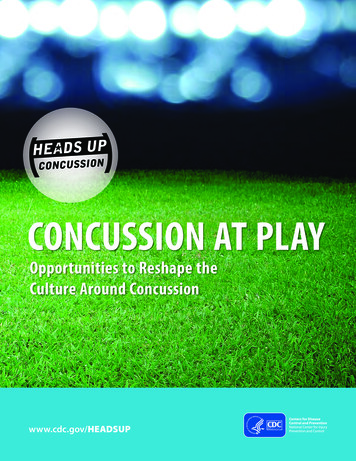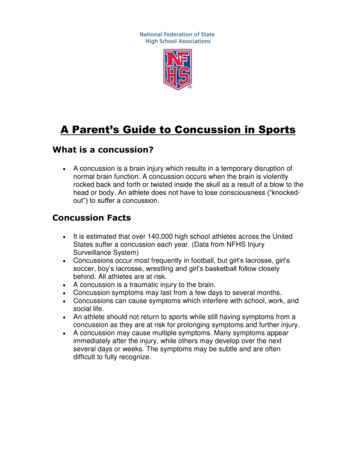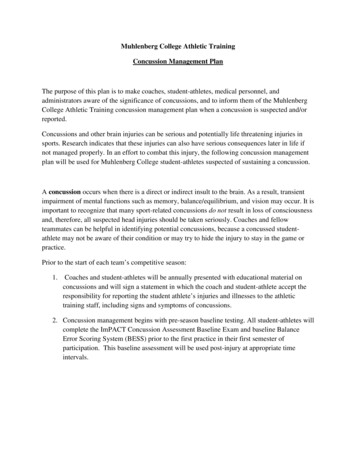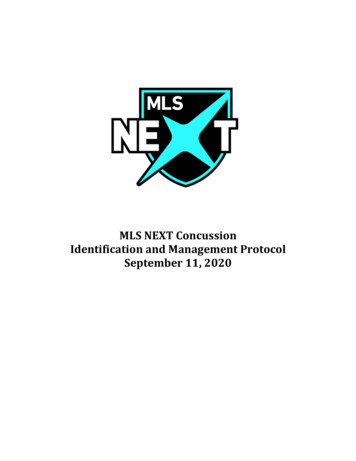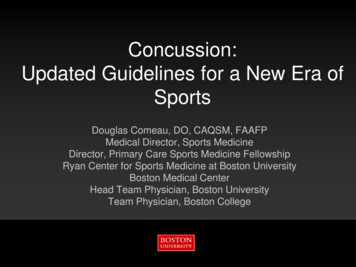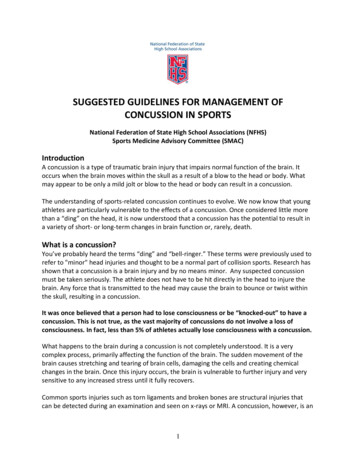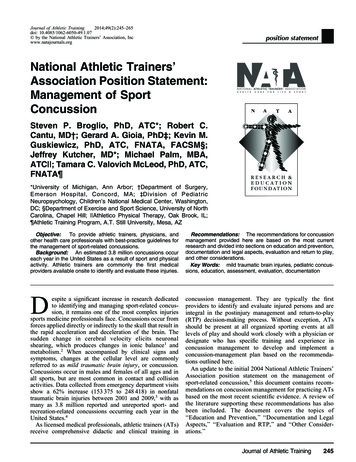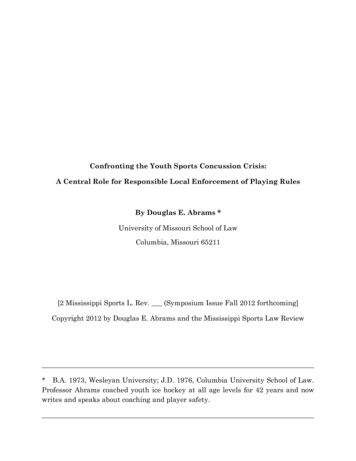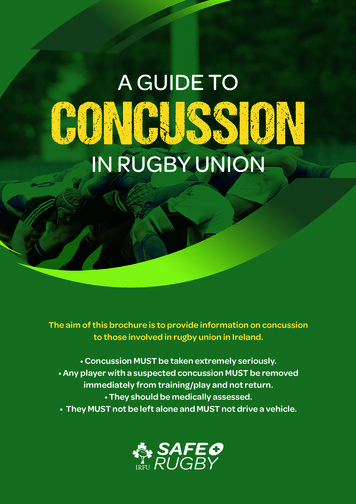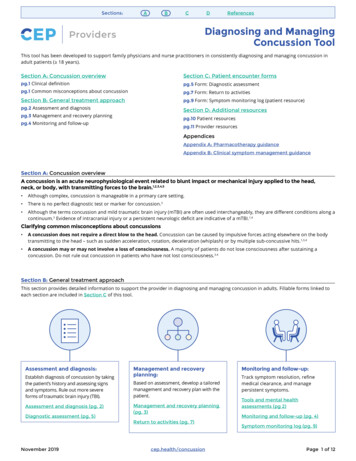
Transcription
Sections:ABCDReferencesDiagnosing and ManagingConcussion ToolThis tool has been developed to support family physicians and nurse practitioners in consistently diagnosing and managing concussion inadult patients ( 18 years).Section A: Concussion overviewSection C: Patient encounter formspg.1 Clinical definitionpg.5 Form: Diagnostic assessmentpg.1 Common misconceptions about concussionpg.7 Form: Return to activitiesSection B: General treatment approachpg.9 Form: Symptom monitoring log (patient resource)pg.2 Assessment and diagnosisSection D: Additional resourcespg.3 Management and recovery planningpg.10 Patient resourcespg.4 Monitoring and follow-uppg.11 Provider resourcesAppendicesAppendix A: Pharmacotherapy guidanceAppendix B: Clinical symptom management guidanceSection A: Concussion overviewA concussion is an acute neurophysiological event related to blunt impact or mechanical injury applied to the head,neck, or body, with transmitting forces to the brain.1,2,3,4,5 Although complex, concussion is manageable in a primary care setting. There is no perfect diagnostic test or marker for concussion.3 Although the terms concussion and mild traumatic brain injury (mTBI) are often used interchangeably, they are different conditions along acontinuum.3 Evidence of intracranial injury or a persistent neurologic deficit are indicative of a mTBI.1,4Clarifying common misconceptions about concussions A concussion does not require a direct blow to the head. Concussion can be caused by impulsive forces acting elsewhere on the bodytransmitting to the head – such as sudden acceleration, rotation, deceleration (whiplash) or by multiple sub-concussive hits.1,3,4 A concussion may or may not involve a loss of consciousness. A majority of patients do not lose consciousness after sustaining aconcussion. Do not rule out concussion in patients who have not lost consciousness.3,4Section B: General treatment approachThis section provides detailed information to support the provider in diagnosing and managing concussion in adults. Fillable forms linked toeach section are included in Section C of this tool.Assessment and diagnosis:Establish diagnosis of concussion by takingthe patient’s history and assessing signsand symptoms. Rule out more severeforms of traumatic brain injury (TBI).Assessment and diagnosis (pg. 2)Diagnostic assessment (pg. 5)Management and recoveryplanning:Based on assessment, develop a tailoredmanagement and recovery plan with thepatient.Management and recovery planning(pg. 3)Return to activities (pg. 7)November 2019cep.health/concussionMonitoring and follow-up:Track symptom resolution, refinemedical clearance, and managepersistent symptoms.Tools and mental healthassessments (pg 2)Monitoring and follow-up (pg. 4)Symptom monitoring log (pg. 9)Page 1 of 12
Sections:ABCDReferencesSection B: General treatment plan (continued)Assessment and diagnosisThe information in this section supports Section C: Diagnostic Assessment Form.The purpose of the diagnostic assessment is to establish diagnosis of concussion by ruling out more severe forms of TBI, cervical spine injuries andmedical and neurological conditions that can present with concussion-like symptoms.1,4,5 In many cases, a concussion may be diagnosed as a result ofan examination of the patient’s history as there may be a delay between injury and presentation to a provider.4 Note: Some individuals may not knowthey have sustained a concussion, and only seek medical care when symptoms do not resolve.2Assessment at presentation1,41. Take a thorough medical history and assessthe patient’s clinical status2. Perform a physical exam Current symptoms and health concerns Setting and mechanism of injury Immediate symptoms after injury Co-occurring injuries Pre-existing medical conditions, including mental health conditions. Previous concussion history Contributing psychosocial factors (have patient complete PHQ-918 and GAD-719) Course of symptoms since time of injury Mental status and cognition Physical status Full neurological evaluation Determine the need for urgent neuroimaging. Use the Canadian CT Head Rule6 or the ONFAssessment/Diagnosis Algorithm to determine if neuroimaging is clinically indicated. Note: UseONF Guide to Neurological and Musculoskeletal Exam.3. Exclude more severe brain injuryNeuroimaging is not recommended to diagnose concussion.4 When it is clinically indicated, the need for neuroimaging should bedetermined using the Canadian CT Head Rule.6 CT scans are the most appropriate to rule out acute intracranial hemorrhage.1Diagnostic criteria for concussion3 Caused by direct or indirect force Rapid onset of neurological function impairment May exhibit neuropathological changes; for example, memory or orientation. Results in a range of clinical signs and symptoms that may not have involved loss of consciousness Symptoms cannot be explained by drug, alcohol, medication use, other injuries or comorbiditiesResources for use immediately post-injury: Glasgow Coma Scale11: A scoring scale for eye-opening as well as motor and verbal responses to objectively measure level of consciousness. Sport Concussion Assessment Tool (SCAT-5)13: Combines aspects of several concussion tools including the Post-Concussion Symptom Scale intoeight components designed to assess concussion symptoms, cognition and neurological signs. Utility decreases significantly 3-5 days after injury.3Resources for use in assessment, diagnosis and management: Canadian CT Head Rule: Algorithm for assessing severity risk in patients with head injury. Acute Concussion Evaluation (ACE)15: A physician/clinician form used to evaluate individuals for concussion. Can be used serially to track symptomrecovery over time. Post-Concussion Symptom Scale (PCSS)16: A 21-item self-report measure recording symptom severity using a 7-point Likert scale. Endorsed bythe International Symposium for Concussion in Sport. Can be used serially to track symptom recovery over time. Rivermead Post-Concussion Symptoms Questionnaire (RPCSQ)17: A 16-item self-report measure of symptom severity asking patients tocompare presence and severity of symptoms experienced within the past 24 hours relative to experience of the same symptoms prior to injury. Patient Health Questionnaire 9 (PHQ-9): A screening tool to assist in the diagnosis of depression and is used to quanitfy symptoms to monitor severity. Generalized Anxiety Disorder 7-item (GAD-7): A screening tool to assist in the diagnosis of anxiety and is used to quanitfy symptoms tomonitor severity. Barrow Neurological Institute (BNI): Fatigue scale.November 2019cep.health/concussionPage 2 of 12
Sections:ABCDReferencesSection B: General treatment plan (continued)Management and recovery planningManagement strategy Relative rest for the first 1-3 days.1,3,5,8 Avoid over-emphasizing rest. Currentevidence indicates that regardless of symptomatic status, activity (as tolerated)is more likely to speed up rather than delay recovery.1,10 Emphasize reassurance and self-management, and set patient expectationsfor recovery. Patients will not be symptom-free when they start to reintegrateactivities and may be anxious about when they will feel better.1 Normalize symptoms and self-management, and set patient expectations forrecovery. Advise the patient to avoid high-risk activities while symptomatic. Advise the patient to gradually perform every day activities within 3 days ofconcussion.1,3,8 Emphasize non-pharmacological interventions.3 There is limited evidenceto support the use of pharmacotherapy. Avoid prescribing medications thatmask symptoms or changes in mental status.1 For more information aboutpharmacotherapy, see Appendix A. Follow-up with the patient within 7-14 days after the diagnosis of a concussion.2Avoid Do not adjust treatment strategy based onmechanism of injury.4 Do not refer to a specialist clinic unless symptompersistence is prolonged. Note: There is no consistent definition ofprolonged or persistent symptoms in the literature.Depending on the source, prolonged or persistentsymptoms refer to those lasting from beyond 2weeks to beyond 3 months.1,2,3,4,5,7 Clinicians shoulduse their judgment on a case-by-case basis.Do not delay return to social and professional rolesmore than medically necessary. Delayed return canresult in demoralization and worsened emotionalsymptoms.1Talking PointsEmphasize non-pharmacological treatment, self-management and goal-setting.“You are the best person to monitor your daily symptoms, with help from your family and friends. Use the Daily Symptom log to recordhow you’re feeling. If your symptoms get worse, remember to step back activities or check the Red Flags. We will go over this log at ournext appointment to see how your symptoms have been progressing.”Developing a recovery planRecovery is defined functionally as a return to normal activities including work, play, school, and sport.3 Full recovery is generally expectedwithin 3 months post-concussion. However, not all patients will recover rapidly with a minimum of 15% of patients experiencing persistentsymptoms beyond 3 months.1Complete the Return to Activities form following the steps below.Identify medicalrestrictions andlimitations Medical restrictions arehigh-risk impairments thatcould result in harm to thepatient or others (e.g. nowork at heights, no ladderwork, no work with heavyequipment, etc.).Medical limitations arefunctional impairmentsthat do not pose risk orharm to the patient orothers, but would interferewith the patient’s abilityto perform tasks (e.g. limitscreen time, limit dualscreen usage, etc.)Medical restrictionsand limitations requireaccommodation fromwork and school.Medical clearance –the decision to lift theserestrictions – can onlybe done by a physicianor nurse practitioner.See ONF Return-to-Discuss gradual return toactivities after initial restperiod Set goals and timelinesfor return to work andschoolReview symptoms patientmay experience whileadding in activities.Patients should expect notto be symptom-free whenthey start to reintegrateactivities, and may beanxious about when theywill feel better.1 Educate patient about red flags.Return to work resources:Provide patient with selfmanagement resources.Section D. Patient resourcesOther resources:Some patients can returnto work or school soonafter injury; some requiremore time. Base timelineson severity of symptomsand consultation with thepatient.1Goal attainment resource:Set date of follow-upappointment Set date of follow-up afterinitial assessment.Provide patient withcompleted Return toActivities form andother resources Complete Return to Provide Patient Symptom Review and providepatient with appropriateActivities FormMonitoring Logpatient resourcesGoal attainment scaling ACE Return to Work plan Vocational Evaluation Return to WorkConsiderations algorithm: Parkwood Pacing GraphsReturn to school resources: EMPWR FoundationReturn-to-Activities toolkit Return to Post-SecondaryActivities Return to Post-SecondaryActivities algorithm Accommodation forstudents with persistentsymptomsActivity / Work / SchoolConsiderations for moredetails.November 2019cep.health/concussionPage 3 of 12
Sections:ABCDReferencesSection B: General treatment plan (continued)Monitoring and follow-upAt follow-up:1. Assess symptoms using validated scale selected duringdiagnostic assessment.2. Review patient Symptom monitoring log3. Have patient complete PHQ-9 and GAD-714. Approve medical clearance when appropriate. Medicalclearance decisions for return to activity can only be madeby a physician or nurse practitioner. See below for medicalcriteria guidance.2,5Improving?YesNoIf symptoms not improving at first follow-up: Initiate symptomatic treatment. Review Appendix B, Clinical Symptom ManagementGuidance Schedule follow-up between 7-14 daysImproving?YesNoIf symptoms improving at follow-up: Encourage patient to continue returning to regular activities,increasing intensity and duration as appropriate. If patient has returned to school, work, or sports, discuss howtransition has affected symptoms. If patient has not returned to school, work, or sports, developtimeline for return. Assess medical restrictions and limitations and adjust asneeded. Provide medical clearance for return to activities as appropriate. Schedule follow-up if clinically indicated.If symptoms not improving 4 weeks post concussion: Initiate bi-weekly follow-up schedule to monitor worseningor new symptoms. Direct management toward specific symptoms whileconsidering etiology, elapsed time from injury, andsymptom interaction. See Appendix B, Clinical SymptomManagement Guidance. Review the patient’s use of prescription medications, overthe-counter medications and supplements. See Appendix A,Pharmacotherapy Guidance. Review the patient’s use of alcohol, cannabis and otherrecreational drugs. Consider re-evaluation and additional diagnostic assessment.Medical clearance decisions for return to activity can only be made by a physician or nurse practitioner. However, patients should beconsidered recovered when they are5: At pre-injury state (asymptomatic or with pre-injury conditions) Able to tolerate full-time work, school and/or activities without symptoms Have a normal neurological examinationNovember 2019cep.health/concussionPage 4 of 12
Sections:ABCDReferencesSection C: Patient encounter formsPT NAMEDATEDOBAGEForm: Diagnostic assessmentUse Section B. Assessment and Diagnosis for support in completing this form.1. HistoryInjury description:Date, time and setting of injury:Time since injury:Reporter (patient, parent, coach, partner, etc.):Type of injury: MVC Pedestrian-MVC Fall Assault Sports Polytrauma: Indirect force Frontal Temporal L / R Neck Occipital Parietal L / R Other:Location of impact:Course of recovery since injury:History of ConcussionDoes patient have history of concussion(s)? How many?:Date of last concussion:Longest symptom duration:Did patient have a complete resolution of all symptoms?:Has it required the same force to cause subsequent concussions?:Notes:Co-occurring conditions History of sleep disorder History of headache/migraine Depression or anxiety disorder Posttraumatic stress disorder (PTSD) Suicidality Substance use disorders Hearing impairment Co-existing orthopedic injury Seizure disorders Attention deficit/hyperactivity disorder Learning disabilities Motion sickness Other:Notes:November 2019cep.health/concussionPage 5 of 12
Sections:ABCDReferencesSection C: Patient encounter forms (continued)2. Physical examPerform a physical exam to assess: Vital signs Cranial nerves Gait and coordination Cervical spine exam Mental status and cognition Extremity tone, strengthand reflexes Scalp/basal skull fracture Any other exams identifiedduring patient historyExclude more severe forms of TBIIf any of the following indications are present, cease assessment for concussion and follow practice for moderate to severe TBI. Evidence of an intracranialinjury or skull fracture Dilation of one or both pupils Weakness/numbness in the extremities Loss of coordination Convulsions or seizures Double vision Increasing confusion, restlessness or agitation Repeated vomiting Slurred speechInitial Diagnosis/Assessment of Adult mTBI (CT scan indication)Canadian CT Head RuleSigns and symptoms of concussion:PhysicalBehavioural/EmotionalCognitive Headache Trouble falling asleep Irritability Feeling “slow” Nausea Excessive sleep Sadness Feeling “foggy” Vomiting Loss of sleep Nervousness Difficulty concentrating Balance problems Drowsiness More emotional Difficulty remembering Dizziness Light sensitivity Numbness Fatigue Noise sensitivity Vision problemsScoresPHQ-9GAD-7PCSSNovember te:Score:cep.health/concussionPage 6 of 12
Sections:ABCDReferencesSection C: Patient encounter forms (continued)PT NAMEDATEDOBAGEForm: Return to activitiesTalking PointsDefine restrictions and limitations.“There are things your concussion will make it harder for you to do.”“If doing certain things with your symptoms has the possibility to cause harm to yourself or others, it will be better for everyone if you giveyourself some more time to recover until I give you medical clearance.”“If doing certain things with your symptoms will seriously impact your ability to do that activity, performance of that activity should belimited until symptoms improve.”Medical restrictions and limitationsRestrictions:Limitations:Gradually returning to activitiesThe purpose of a gradual approach is to add activities slowly to see how they affect the patient’s symptoms. A slow return to regular activitieswill help speed recovery. Reassure the patient they will not be symptom-free immediately once they start to reintegrate activities. Let the patientknow that they may experience some discomfort as they aim to advance in activities. If symptoms do not worsen concerningly, then the patientcan increase duration or intensity of given activity.A 24-hour period is the recommended time frame for each step. If symptoms worsen substantially with the addition of a new activity or the increase inintensity of an activity, advise the patien to step back the activity to a lower level that previously felt manageable for another 24 hours before trying again.If your patients experience any of these Red Flag symptoms, use your clinical discretion to advise them to visit the emergency department.PhysicalRed Flags.Visit the EmergencyDepartment if suddenlyexperiencing any of thesesymptoms.Thinking Worsening headaches Increasing confusion Seizures Slurred speech Neck pain Cannot recognize peopleor places Repeated vomiting Weakness/numbness inarms or legs Loss of consciousnessEmotionalSleep Unusual behaviourchange Increasing irritabilityCannot be awakenedAn example of gradually returning to activitiesRest periodScreen timeNoneActivity day 1Activity day 2Activity day 3Activity day 4Activity day 5MinimalMinimal, butincreasedIncreasedNear NormalNormalFor more examples of slowly returning to activities, please visit EMPWR.PhysicalCommon symptoms duringrecoveryNovember 2019ThinkingEmotionalSleep Headache Balance problems Feeling mentally foggy Irritability Drowsiness Nausea Problems concentrating Sadness FatigueSensitivity to lightor noise Feeling more emotional DizzinessVisual problemsProblems rememberingSleeping more thanusual NervousnessVomitingFeeling more sloweddown Numbness/tingling Sleeping less thanusual Trouble falling asleepcep.health/concussionPage 7 of 12
Sections:ABCDReferencesSection C: Patient encounter forms (continued)Set goals and timelines with patient for return to workand schoolUse resources from Section B. Management and recoveryplanning.Should patient try returning to work/school before follow-up? Yes NoIf yes, conditions: Medical restrictions Medical limitations Part-time or limited hoursIf no: discuss timeline at follow-upFollow-up date:November 2019 Consider sharing a copy of this form with patient Consider printing a copy of the Symptom MonitoringLog (pg. 9) Consider printing a copy of the Patient resources(pg 10)cep.health/concussionPage 8 of 12
Sections:ABCDReferencesSymptom monitoring logDate (D/M/YY)TimeActivity(e.g. work, class,meeting, homework,cooking, driving, etc.)November 2019Alone?(Yes or no)Symptomatic?(Yes or No)Symptomintensity:If yes, number ofpeople presentIf yes, list symptoms1 low intensity6 highest intensitycep.health/concussionPage 9 of 12
Sections:ABCDReferencesSection D: Additional resourcesPatient resourcesSelf-management[i]Sunnybrook Mild Traumatic Brain Injury/Concussion Handbook: https://sunnybrook.ca/content/?page bsp-brain-injury-educationSubsections include: Concussions and getting better: https://sunnybrook.ca/content/?page bsp-about-concussions Toolkit for Recovery: https://sunnybrook.ca/content/?page bsp-understanding-concussion Personal Recovery Plan: https://sunnybrook.ca/content/?page bsp-concussion-recovery-plan[ii]Post-Injury Advice Card (ONF): Short version: dmin/media/appendices/appendix-1-4-2.pdf Long version: ion Do’s and Don’ts: The first few days of recovery: A hand-out for patients with reminders on what to do and what not to do forindividuals who are suffering from symptoms of concussion.Available from: n Care Guide (St. Joseph’s Health Care London): A hand-out that patients can print out and keep with them as a resource forthe first 48 hours after a concussion. It includes topics such as driving after displaying concussion symptoms, when to seek medicalattention and how to return to the patient’s normal levels of activity.Available from: pdf/abi concussion care guide07.26.17.pdfEducation, legal issues and community resources[v]Concussion Frequently Asked Questions – FAQs (Ontario Brain Injury Association): A list of seven commonly asked questions by patientsincluding legal issues surrounding concussions. Available from: http://obia.ca/concussion-resources/[vi]Ontario Brain Injury Association Helpline (OBIA): A toll-free helpline available Monday to Friday from 9am to 5pm for patients to speakwith someone personally. Helpline number: 1-800-263-5404.[vii] Online Concussion Support Group (OBIA): A free online support group (registration required) for patients living or having lived withconcussion symptoms to share their feelings and experiences. The group runs for 60 minutes per week over eight weeks and is availablevia computer or phone. Registration here: ii] Regional Acquired Brain Injury Program: Information for Families (St. Joseph’s Health Care London): A resource for concussion patient’sfamily members on how they can help their loved ones.Available from: ain-injury-program/families[ix]What Brain Injury Survivors Want You to Know (Brainline): A resource for patients, families and friends on communicating with braininjury survivors. Available from: brain-injury-survivors-want-you-know[x]Personal Stories (Concussion Legacy Foundation): Survivors of concussion share their own personal stories about having lived or livingwith concussion symptoms. Available from: esPrevention[xi]Protecting your brain from having another injury (Sunnybrook Health Sciences Centre): Information about preventing futureconcussions. Available from: https://sunnybrook.ca/content/?page bsp-concussion-protect-brain[xii]Heads Up: Preventing Mild Traumatic Brain Injury (MBTI) (Brain Injury Canada): A list of preventative tactics patients can do to prevent futureconcussions. This resource includes some questions to ask primary care providers regarding prevention and returning to patient’s baselineactivities. Available from: ember 2019cep.health/concussionPage 10 of 12
Sections:ABCDReferencesSection D: Additional resources (continued)Provider resources:Point-of-care tools and care pathways[i]Initial Diagnosis/Assessment of Adult mTBI – CT scan indication algorithm (ONF).Access at: n CT Head Rule: Algorithm for assessing severity risk in patients with head injury.Access at: dmin/media/figures/figure-1-1.png[iii]Standards for Post-Concussion care: From diagnosis to the interdisciplinary concussion clinic, a tool for clinicians supporting thefull clinical course of concussion. Includes concussion care pathway, referral indicators, symptom management, and patient/familyeducation resources. sion-care[iv]Patient Health Questionnaire 9 (PHQ-9): A screening tool to assist in the diagnosis of depression and is used to quanitfy symptoms tomonitor severity. Access at: onnaire-9[v]Generalized Anxiety Disorder 7-item (GAD-7): A screening tool to assist in the diagnosis of anxiety and is used to quanitfy symptoms tomonitor severity. Access at: der-7[vi]BNI (Barrow Neurological Institute) Fatigue scale. Access at: dmin/media/appendices/appendix-11-1.pdf[vii] Guide to Neurological and Musculoskeletal Exam (ONF). Access at: dmin/media/appendices/appendix-3-4.pdfPatient support in return to work, school and activities[viii] ACE Return to Work Care Plan:Access at: dmin/media/appendices/appendix-12-5.pdf[ix]ACE Return to School Care Plan:Access at: dmin/media/appendices/appendix-12-6.pdfClinical Practice Guidelines[x]Guideline for Concussion/Mild Traumatic Brain Injury & Persistent Symptoms, 3rd Edition [Internet]. Ontario Neurotrauma Foundation;2018. Available from: ds for Post-Concussion care: From diagnosis to the interdisciplinary concussion clinic, a tool for clinicians supporting thefull clinical course of concussion. Includes concussion care pathway, referral indicators, symptom management, and patient/familyeducation resources. sion-care[xii] Consensus statement on concussion in sport—the 5th international conference on concussion in sport. Berlin, October 2016. Br J SportsMed. 2017 Apr 26; bjsports-2017-097699. Available from: https://bjsm.bmj.com/content/51/11/838[xiii] VA/DoD Clinical Practice Guideline for the Management of Concussion-Mild Traumatic Brain Injury, v. 2.0 [Internet]. Department ofVeterans Affairs, Department of Defense; 2016.Available from: mtbi/mTBICPGFullCPG50821816.pdf[xiv] Canadian Guideline on Concussion in Sport [Internet]. Parachute; 2017. Available from: in-sport/Other resources[xv] The Concussion Awareness Training Tool: An accredited medical professional course designed to provide medical professionals with theinformation they need to provide evidence-based care for their patients who have sustained a concussion.Available here: /[xvi] Specialized Concussion Clinics in Ontario: A list of various specialized concussion clinics in Ontario. The list is not comprehensive but ismeant to give providers guidance on some available services.Available here: dmin/media/appendices/appendix-2-1.pdfNovember 2019cep.health/concussionPage 11 of 12
Sections:ABCDReferencesReferences[1]Guideline for Concussion/Mild Traumatic Brain Injury & Persistent Symptoms, 3rd Edition[Internet]. Ontario Neurotrauma Foundation; 2018. [cited 2019 June 3]. Available ssion-mtbi-persistent-symptoms-third-edition[10] Lal A, Kolakowsky-Hayner SA, Ghajar J, Balamane M. The Effect of Physical Exercise After aConcussion: A Systematic Review and Meta-analysis. Am J Sports Med. 2018 Mar;46(3):743–52.[cited 2019 June 3].[2]Standards for Post-Concussion Care [Internet]. Ontario Neurotrauma Foundation; 2017. [cited2019 June 3]. Available from: sion-care[11] Teasdale G, Jennett B. Assessment of coma and impaired consciousness. A practical scale. Lancet.1974 Jul 13;304(7872):81–4. [cited 2019 June 3].[3]McCrory P, Meeuwisse W, Dvorak J, Aubry M, Bailes J, Broglio S, et al. Consensus statement onconcussion in sport—the 5 th international conference on concussion in sport held in Berlin,October 2016. [cited 2019 June 3]. Br J Sports Med. 2017 Apr 26;bjsports-2017-097699.[12] McRae M, Kelly J, Randolph C. Standardized Assessment of Concussion (SAC): Manual forAdministration, Scoring and Interpretation. Waukesha, WI: CNS Inc; 1996. [cited 2019 June 3].[4]VA/DoD Clinical practice guideline for the management of concussion - mild traumatic braininjury, v. 2.0 [Internet]. Department of Veterans Affairs, Department of Defense; 2016. [cited2019 June 3]. Available from: mtbi/mTBICPGFullCPG50821816.pdf[5]Canadian Guideline on Concussion in Sport [Internet]. Parachute; 2017. [cited 2019 June 3].Available from: in-sport/[13] Echemendia RJ, Meeuwisse W, McCrory P, Davis GA, Putukian M, Leddy J, et al. TheSport Concussion Assessment Tool 5th Edition (SCAT5). Br J Sports Med. 2017 Apr26;bjsports-2017-097506. [cited 2019 June 3].[14] Alsalaheen B, Stockdale K, Pechumer D, Broglio SP. Validity of the Immediate Post ConcussionAssessment and Cognitive Testing (ImPACT). Sports Med. 2016 Oct;46(10):1487–501. [cited 2019June 3].[15] Gioia GA, Collins M, Isquith PK. Improving Identification and Diagnosis of Mild Traumatic BrainInjury With Evidence: Psychometric Support for the Acute Concussion Evaluation. J Head TraumaRehabil. 2008 Jul;23(4):230–42. [cited 2019 June 3].[6]Stiell IG, Wells GA, Vandemheen K, Clement C, Lesiuk H, Laupacis A, et al. The Canadian CTHead Rule for patients with minor head injury. The Lancet. 2001 May;357(9266):1391–6. [cited20
A concussion is an acute neurophysiological event related to blunt impact or mechanical injury applied to the head, neck, or body, with transmitting forces to the brain.1,2,3,4,5 Although complex, concussion is manageable in a primary care se tting. 3There is no perfect diagnostic test or marker for concussion.
